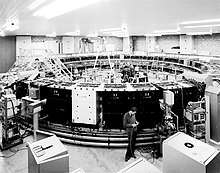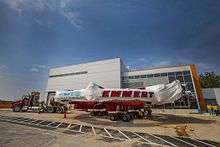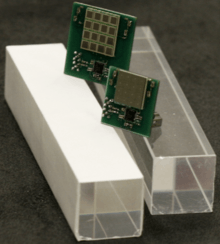Muon g-2
Muon g−2 (pronounced "gee minus two") is a particle physics experiment at Fermilab to measure the anomalous magnetic dipole moment of a muon to a precision of 0.14 ppm,[1] which will be a sensitive test of the Standard Model. It might also provide evidence of the existence of entirely new particles.[2]
_ring.jpg)
The muon, like its lighter sibling the electron, acts like a spinning magnet. The parameter known as the "g-factor" indicates how strong the magnet is and the rate of its gyration. The value of g is slightly larger than 2, hence the name of the experiment. This difference from 2 (the "anomalous" part) is caused by higher-order contributions from quantum field theory. In measuring g−2 with high precision and comparing its value to the theoretical prediction, physicists will discover whether the experiment agrees with theory. Any deviation would point to as yet undiscovered subatomic particles that exist in nature.[3]
The three data-taking periods (Run-1 to Run-3) have been completed, with preparations for Run-4 currently ongoing. The data analysis is still ongoing as of July 2020.[4][5]
Timeline
Muon g−2 at CERN
The first muon g−2 experiments were born at CERN in 1959 under the initiative of Leon Lederman.[6][7] A group of six physicists formed the first experiment, using the Synchrocyclotron at CERN. The first results were published in 1961,[8] with a 2% precision with respect to the theoretical value, and then the second ones with this time a 0.4% precision, hence validating the quantum electrodynamics theory.

A second experiment started in 1966 with a new group, working this time with the Proton-Synchrotron, still at CERN. The results were then 25 times more precise than the previous ones and showed a quantitative discrepancy between the experimental values and the theoretical ones, thus required the physicists to recalculate their theoretical model. The third experiment, which started in 1969, published its final results in 1979,[9] confirming the theory with a precision of 0.0007%. Since 1984, the United States took over the g−2 experiment.[10]
Muon g−2 at Fermilab
Fermilab is continuing an experiment conducted at Brookhaven National Laboratory[11] to measure the anomalous magnetic dipole moment of the muon. The Brookhaven experiment ended in 2001, but ten years later Fermilab acquired the equipment, and is working to make a more accurate measurement (smaller σ) which will either eliminate the discrepancy or confirm it as an experimentally observable example of physics beyond the Standard Model.
The magnet was refurbished and powered on in September 2015, and has been confirmed to have the same 1300 ppm basic magnetic field uniformity that it had before the move.
As of October 2016 the magnet has been rebuilt and carefully shimmed to produce a highly uniform magnetic field. New efforts at Fermilab have resulted in a three-fold improved overall uniformity, which is important for the new measurement at its higher precision goal.[12]
In April 2017 the collaboration was preparing the experiment for the first production run with protons – to calibrate detector systems. The magnet received its first beam of muons in its new location on May 31, 2017.[13] Data taking will run until 2020.[14]
Theory of magnetic moments
The magnetic dipole moment (g) of a charged lepton (electron, muon, or tau) is very nearly 2. The difference from 2 (the "anomalous" part) depends on the lepton, and can be computed quite precisely based on the current Standard Model of particle physics. Measurements of the electron are in excellent agreement with this computation. The Brookhaven experiment did this measurement for muons, a much more technically difficult measurement due to their short lifetime, and detected a tantalizing, but not definitive, 3σ discrepancy between the measured value and the computed one (0.0011659209 versus 0.0011659180).[15]
The measurement of the electron's g−2 is the most precisely determined quantity in physics. It has recently been measured to 3 parts in 1013 and its value calculated in QED from a summation of 12,672 Feynman diagrams. However despite these amazing experimental and theoretical feats, the (m/M)2 contribution from new particles is only discernible for small values of mass (i.e. mass < 100 MeV) and presently the measured and predicted values are in good agreement. In contrast a measurement of the g−2 of the muon, whose mass is 220 times that of the electron, has a sensitivity to new particles with masses in the range 10 MeV to 1000 GeV and thus at the upper end is probing a similar mass region to the LHC experiments but in a very different way. The muon g−2 measurement can also probe low mass physics below the sensitivity of the LHC.[16]
Design

Central to the experiment is a 50-foot (15 m)-diameter superconducting magnet with an exceptionally uniform magnetic field. This was transported, in one piece, from Brookhaven in Long Island, New York, to Fermilab in the summer of 2013. The move traversed 3,200 miles over 35 days,[17] mostly on a barge down the East Coast and through Mobile, Alabama to the Tennessee–Tombigbee Waterway and then briefly on the Mississippi. The initial and final legs were on a special truck traveling closed highways at night.

Detectors
The magnetic moment measurement is realised by 24 electromagnetic calorimeter detectors, which are distributed uniformly on the inside of the storage ring. The calorimeters measure the energy and time of arrival (relative to the injection time) of the decay positrons (and their count) from the muon decay in the storage ring. After a muon decays into a positron and two neutrinos, the positron ends up with less energy than the original muon. Thus, the magnetic field curls it inward where it hits a segmented lead fluoride calorimeter read out by silicon photo-multipliers (SiPM).[18]
The tracking detectors register the trajectory of the positrons from the muon decay in the storage ring. The tracker can provide a muon electric dipole moment measurement, but not directly the magnetic moment measurement. The main purpose of the tracker is to measure the muon beam profile, as well as resolution of pile-up of events (for reduction of the systematic uncertainty in the calorimeter measurement).[18]
Magnetic field
To measure the magnetic moment to ppb level of precision requires a uniform average magnetic field to be of the same level precision. The experimental goal of g−2 is to achieve an uncertainty level on the magnetic to 70 ppb averaged over time and muon distribution. A uniform field of 1.45 T is created in the storage ring using superconducting magnets, and the field value will be actively mapped throughout the ring using an NMR probe on a mobile trolley (without breaking the vacuum). The probe utilises the Larmor frequency of a proton in a spherical water sample for a high precision measurement of the magnetic field.[18]
Data acquisition
An essential component of the experiment is the data acquisition (DAQ) system, which manages the data flow from the detector electronics. The requirement for the experiment is to acquire raw data at a rate of 18 GB/s. This is accomplished by employing parallel data-processing architecture using 24 high-speed GPUs (NVIDIA Tesla K40) to process data from 12 bit waveform digitisers. The set-up is controlled by the MIDAS DAQ software framework. The DAQ system processes data from 1296 calorimeter channels, 3 straw tracker stations, and auxiliary detectors (e.g. entrance muon counters). The total data output of the experiment is estimated at 2 PB.[19]
Collaboration
The following universities, laboratories, and companies are participating in the experiment:[20]
Universities
- Boston University
- Cornell University
- University of Groningen
- University of Illinois at Urbana-Champaign
- James Madison University
- Korea Advanced Institute of Science and Technology (KAIST)
- University of Kentucky
- University of Liverpool
- Lancaster University
- University College London
- University of Massachusetts
- Michigan State University
- University of Michigan
- University of Mississippi
- Università del Molise
- Universita' degli Studi di Napoli Federico II
- North Central College
- Northern Illinois University
- Northwestern University
- University of Oxford
- Regis University
- Shanghai Jiao Tong University
- Technische Universitat Dresden
- University of Texas
- Università di Udine
- University of Virginia
- University of Washington
- Yale University
- York College, CUNY
Laboratories
- Argonne National Laboratory
- Brookhaven National Laboratory
- Fermi National Accelerator Laboratory
- Budker Institute of Nuclear Physics
- Istituto Nazionale di Fisica Nucleare
- Joint Institute for Nuclear Research, Dubna
- Laboratori Nazionali di Frascati
- INFN, Sezione di Napoli
- INFN, Sezione di Pisa
- Institute for Basic Science, S. Korea
References
- "Muon g−2 Experiment". Muon g−2 Experiment. Fermilab. Retrieved April 26, 2017.
- Gibney, Elizabeth (April 13, 2017). "Muons' big moment could fuel new physics". Nature. 544 (7649): 145–146. Bibcode:2017Natur.544..145G. doi:10.1038/544145a. PMID 28406224.
- "Muon g−2 Collaboration to Solve Mystery". Muon g−2 Experiment. Fermilab. Retrieved April 30, 2017.
- "This Locked Cabinet Holds the Answer to One of the Biggest Questions in Particle Physics". Gizmodo. January 25, 2020.
- "Muon g-2 begins second run". phys.org. March 26, 2019.
- Farley, Francis (2004). "The dark side of the muon". In Luis Álvarez-Gaumé (ed.). Infinitely CERN : memories of fifty years of research, 1954-2004. Geneva: Editions Suzanne Hurter. pp. 38–41. ISBN 978-2-940031-33-7. OCLC 606546795.
- "Archives of Muon g-2 experiment". CERN Archive. 2007. Retrieved March 4, 2020.
- Charpak, Georges; Garwin, Richard L; Farley, Francis J M; Müller, T (1994). "Results of the g-2 experiment". In Cabibbo, N (ed.). Lepton Physics at CERN and Frascati. World Scientific. pp. 34–. ISBN 9789810220785.
- Combley, F; Farley, F.J.M; Picasso, E (1981). "The CERN muon (g-2) experiments". Physics Reports. 68 (2): 93–119. doi:10.1016/0370-1573(81)90028-4. ISSN 0370-1573.
- "Enigma of the muon". European Organization for Nuclear Research (CERN). Retrieved 19 July 2018.
- Farley, F (2004). "The 47 years of muon g−2". Progress in Particle and Nuclear Physics. 52 (1): 1–83. doi:10.1016/j.ppnp.2003.09.004. ISSN 0146-6410.
- Holzbauer, J. L. (December 9, 2016). "The Muon g−2 Experiment Overview and Status as of June 2016". Proceedings, 12th International Conference on Beauty, Charm, and Hyperons in Hadronic Interactions (BEACH 2016): Fairfax, Virginia, USA, June 12–18, 2016. XIIth International Conference on Beauty, Charm, and Hyperons in Hadronic Interactions. J. Phys. Conf. Ser. 770. p. 012038. arXiv:1610.10069. doi:10.1088/1742-6596/770/1/012038. Via inSPIRE
- "Muon Magnet's Moment Has arrived" (Press release). Fermilab. May 31, 2017.
- Gohn, W. (November 15, 2016). "The muon g−2 experiment at Fermilab". 18th International Workshop on Neutrino Factories and Future Neutrino Facilities Search (NuFact16) Quy Nhon, Vietnam, August 21–27, 2016. (For Muon g'−2 Collaboration). arXiv:1611.04964. Via inSPIRE
- Hagiwara, K.; Martin, A.D.; Nomura, Daisuke; Teubner, T. (May 2007). "Improved predictions for g−2 of the muon and αQED(M 2
Z )". Physics Letters B. 649 (2–3): 173–179. arXiv:hep-ph/0611102. Bibcode:2007PhLB..649..173H. CiteSeerX 10.1.1.346.6143. doi:10.1016/j.physletb.2007.04.012. - "FNAL g−2 Experiment". Muon g−2 Experiment. UCL. Retrieved April 30, 2017.
- Hertzog, David; Roberts, Lee (October 27, 2014). "Muon g−2 storage ring starts a new life". CERN Courier. Retrieved April 26, 2017.
- Grange, J.; et al. (Muon g−2 Collaboration) (January 27, 2015). "Muon (g−2) Technical Design Report". arXiv:1501.06858. Bibcode:2015arXiv150106858G. Missing or empty
|url=(help) Via inSPIRE - Gohn, W. (November 15, 2016). "Data Acquisition with GPUs: The DAQ for the Muon g−2 Experiment at Fermilab". Proceedings, 38th International Conference on High Energy Physics (ICHEP 2016): Chicago, IL, USA, August 3–10, 2016. (For Muon g−2 Collaboration). p. 174. arXiv:1611.04959. Bibcode:2016arXiv161104959G. doi:10.22323/1.282.0174. Via inSPIRE
- "Muon g−2 Collaboration". Muon g−2 Experiment. Fermilab. Retrieved April 26, 2017.